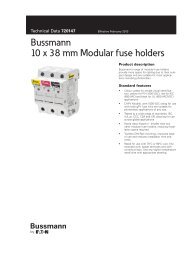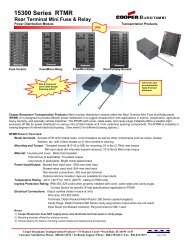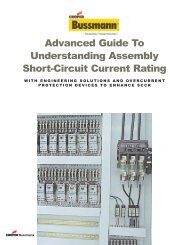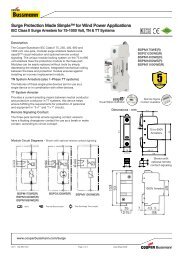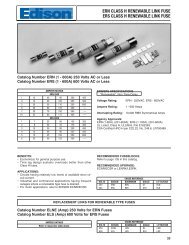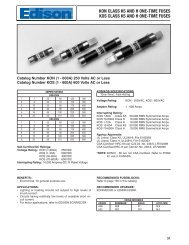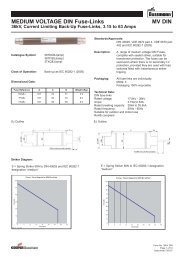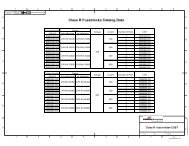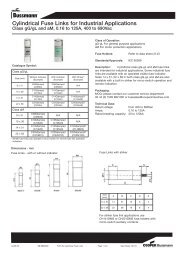Selective Coordination - Cooper Bussmann
Selective Coordination - Cooper Bussmann
Selective Coordination - Cooper Bussmann
Create successful ePaper yourself
Turn your PDF publications into a flip-book with our unique Google optimized e-Paper software.
<strong>Selective</strong> <strong>Coordination</strong>Essential Electrical Systems In Healthcare Facilities, Emergency Systems and LegallyRequired Standby SystemsA given emergency branch circuit load has a circuit path up through to themain on the normal source and another circuit path up through to the main onthe emergency source. The requirement for selective coordination means thatall the overcurrent protective devices must be selectively coordinated witheach other, from each emergency branch circuit up through to the main of thenormal power supply and up through to the main on the emergency powersupply. See following example:3. A coordination study should fully investigate, interpret, and present thelevel of coordination achieved for the full system and for the determinedamount of available short-circuit currents. This requires a person qualified forthis task. Too often, coordination studies are performed where the deliverable isjust time current curve plots with no interpretation or discussion on the level ofcoordination achieved (or sacrificed). Also, the studies should be performed in thedesign phase so that if the study results prompt a change, the change can bewithout major ramifications.Fusible Systems<strong>Cooper</strong> <strong>Bussmann</strong> makes it easy to design fusible systems that are selectivelycoordinated. For the modern current-limiting fuses, selectivity ratios arepublished (see Fuse Selectivity Ratio Guide section). It is not necessary to plottime current curves or do a short-circuit current analysis; all that is necessaryis to make sure the fuse types and ampere rating ratios for the mains, feedersand branch circuit meet or exceed the selectivity ratio. These selectivity ratiosare for all levels of overcurrent up to the interrupting ratings of the respectivefuses. The ratios are valid even for fuse opening times less than 0.01seconds. This means with current-limiting fuses, it is not necessary to do anyanalysis for less than 0.01 seconds when the fuse types and ampere ratingratios adhere to the selectivity ratios. The industry standard for publishing fusetime current curves is to plot the times from 0.01 seconds and longer. Thefollowing example illustrates all that is necessary to achieve selectivecoordination with a fusible system.How Can <strong>Selective</strong> <strong>Coordination</strong> Be Achieved?<strong>Selective</strong> coordination of the overcurrent protective devices for these lifesafety systems for both the normal power source path and the alternate powersource path can be achieved with either modern current-limiting fusetechnology or modern circuit breaker technology. However, not all fuse typesor circuit breaker types can be used in any and all situations to ensureselective coordination. The ability to achieve selective coordination dependson the specific circuit parameters (short-circuit currents available at variouspoints in the system) and the fuse or circuit breaker opening characteristicsand possible setting options. Proper overcurrent protective device choice andselective coordination analysis is absolutely necessary. However, if the properchoices and analysis are not made so that selective coordination is ensured,the system may be built with deficiencies that may negatively impact lifesafety.Other Important Considerations1. Either a system has overcurrent protective devices that are selectivelycoordinated or the system does not. There is no middle ground. When termssuch as “enhancing” coordination, “optimizing” coordination, coordination "to thebest degree possible," or similar terms are used, it generally means theovercurrent protective devices are not selectively coordinated over the full rangeof short-circuit currents that are available in the application.2. <strong>Selective</strong> coordination is for the full range of overcurrents available at allmains, feeders and branch circuits. It is not acceptable to arbitrarily considerselective coordination is applicable only above certain times such as 0.01, 0.1, or1.0 seconds. The coverage of selective coordination in the sections on <strong>Selective</strong><strong>Coordination</strong> for Fuses and Circuit Breakers of this SPD publication explains howto assess fuses and circuit breakers for the full range of overcurrents irrespectiveof the times. Also, these preceding sections provide some easy, quick methods toassess selective coordination for both fuse and circuit breaker systems.©2005 <strong>Cooper</strong> <strong>Bussmann</strong>101



